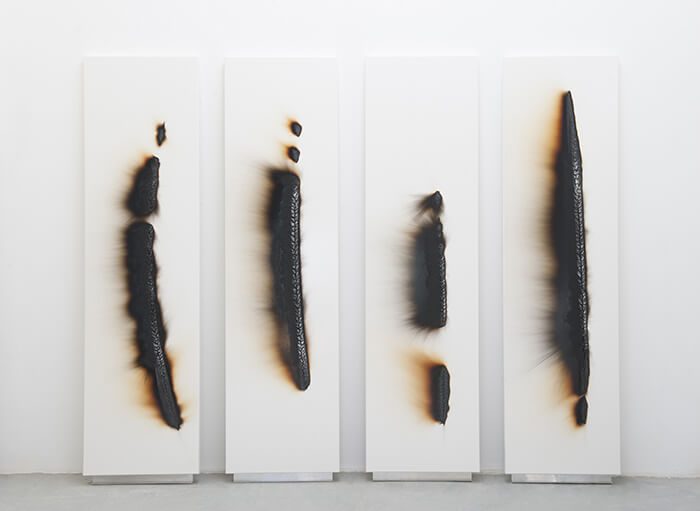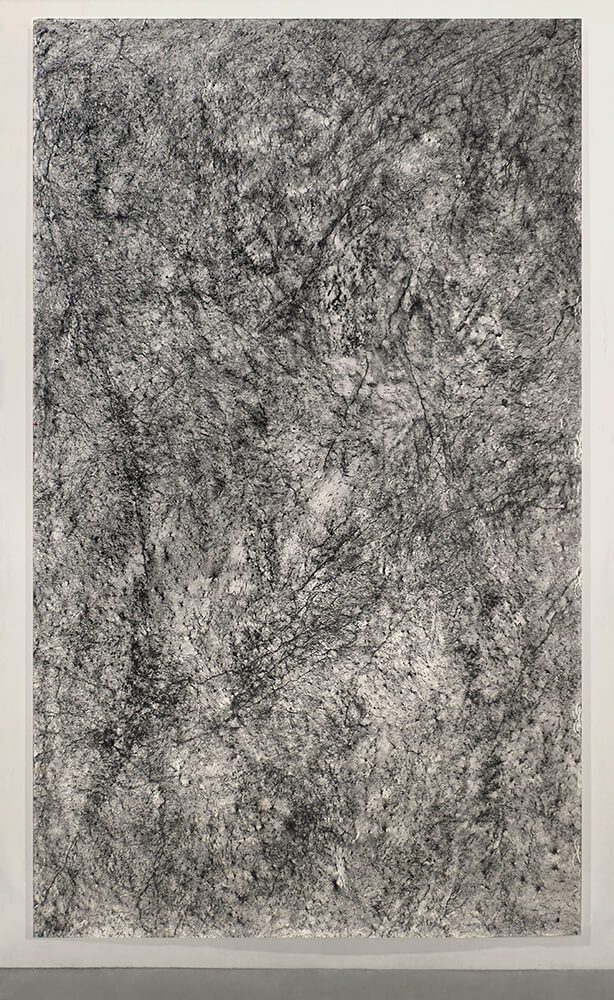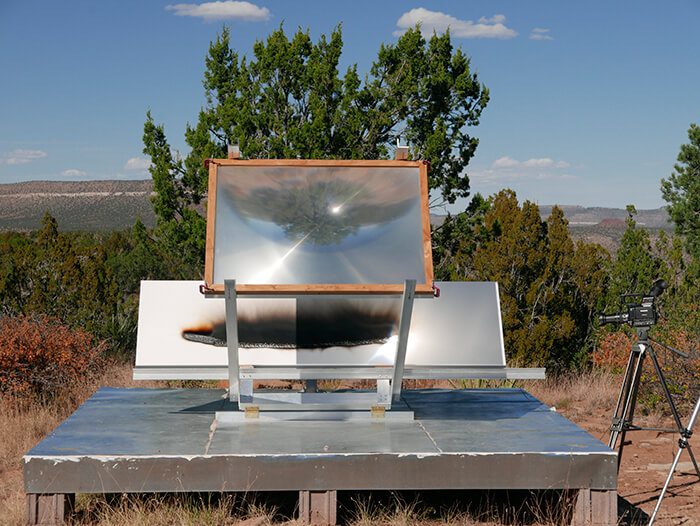
June 9 – July 15, 2017
Mayeur Projects, Las Vegas, NM
I imagine them as children: O’Bryan on the sidewalk, rubbing the concrete with chalk, while Ross sits in the grass and fries ants with a magnifying glass. This comes to me only after I learn how the works that comprise Inside Nature and Time (June 9-July 15, 2017) were made. At first I was just imagining how Ross might have created his solar burns, what surface O’Bryan might have been tracing onto her paper. The catalogue photos show both artists’ processes. There’s Jill crouched on a huge sheet of paper held down with rocks. Ross is noticeably absent from the photo of a lens tilted toward the sun, his device at work without the body of the artist.
O’Bryan’s work is insistently embodied. She has described her drawings as “archives of motion.” She does not draw the landscape—or even draw in the landscape. Her frottage drawings, like nm.8.06 (2006), are about being on the ground, sprawled out, feeling the stone and dirt beneath her with graphite through paper. Her process shows in the scale of the drawing, the duration in place it signifies, the steady ground unmoving against her. Her breath drawings, 31,616 breaths between July 5 and August 12, 2012, and 13,280 breaths between August 12 and September 30, 2012, are visual and tactile archives of being in her body, each breath registered as a mark, the rice paper so soaked in graphite its frayed edges appear dyed. She asks—and answers—how do you transfer earthly embodiment, earthly engagement to paper?

And how do you embody the celestial—sunlight, starlight—in art? I perceive this to be Charles Ross’s project. When I first saw his Human Sized Solar Burns, I could think only of skin, of the feeling of sun singeing my body the moment I walk outside in northern New Mexico’s high altitude. The sun is closer here. I thought, too, of depleted ozone, of the sun’s increasing deadliness on a warming planet. The burns themselves look like charred wood after a campfire or a wildfire, the centers cracked open and shiny gray, the edges smoky and spreading. His time-lapse photograph Star Axis, Star Trails 1 Hour Thirty Minutes is less immediately physical. It seems to be more about capturing light and the earth’s turning, though of course these are also burns, light passing through a lens to leave its mark. Again I wonder, where is Ross?
Ross’s Future Light Cone (1989/1991), the oldest work in the show, and O’Bryan’s series of Vessels, Vessel (In) (2016), Vessel (sn) (2016), and Vessel (sw), installed a room away, echo each other’s shapes and point out and beyond the other works. They signal Ross’s longstanding mathematical obsession with prisms and refracted light, evident at the nearby Dwan Light Sanctuary, where rainbow shapes circle the walls and revolve throughout the day. Like the Star Axis, Star Trails, and like O’Bryan’s breath drawings, the artist’s abstract works are steeped in the quotidian, tracking the earth’s rotation. O’Bryan’s Vessels are less immediately legible to me, but they are, with the solar burns, the show’s most recent works. They signal possible new directions for O’Bryan. From the transfer of ground to skin through paper, to the distillation of breath into pencil mark, perhaps O’Bryan reaches now for the liquid manifestations of life, the body as container. Her vessels are empty, waterless, a bleak reflection of desiccation, drought, water diversion. And yet they are made of plaster, of minerals and sand soaked in water, shaped, and then dried. They are, to me, hopeful, open, awaiting a coming rain to fill and provide replenishment.

Each of the works in Inside Nature and Time generates a landscape unto itself. The ridges in the graphite of O’Bryan’s breaths, the terrain of Ross’s solar burns, charred hills and valleys, and O’Bryan’s topographical map, scaled precisely to the rock she traces (a callback to Jean Baudrillard’s map of the world the size of the world, a flash of the hyperreal made concrete). And yet it is a map to nowhere obviously significant, but to the top of the mesa that O’Bryan and Ross share, burning and etching their coordinates into their work in a sort of whispered refrain: we are here.



